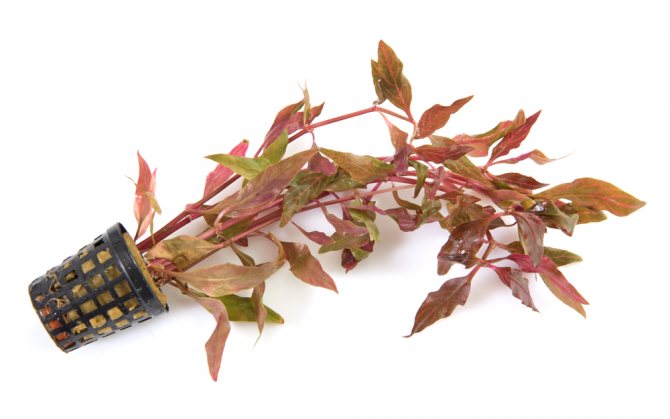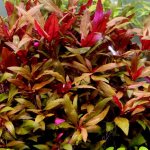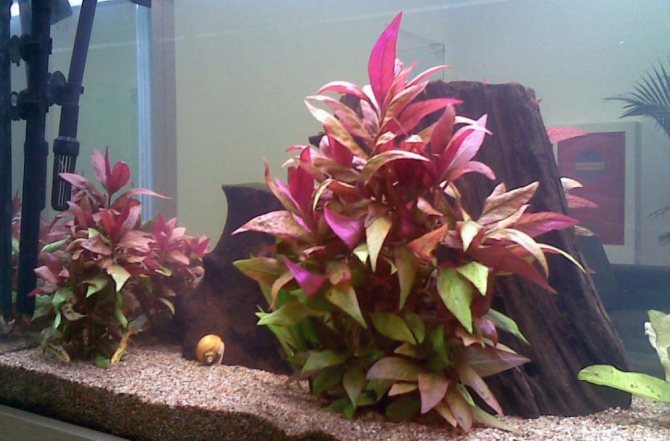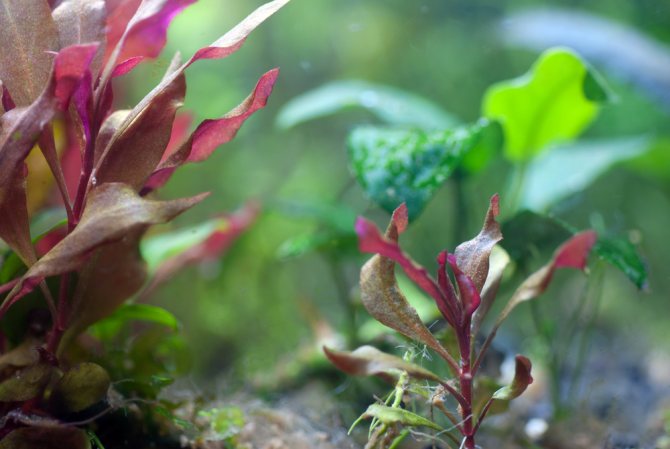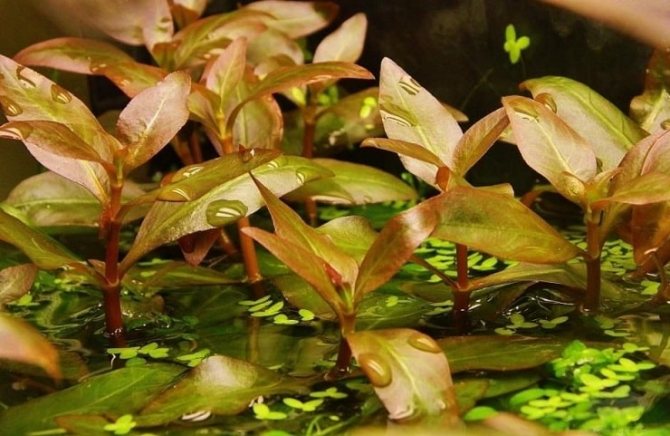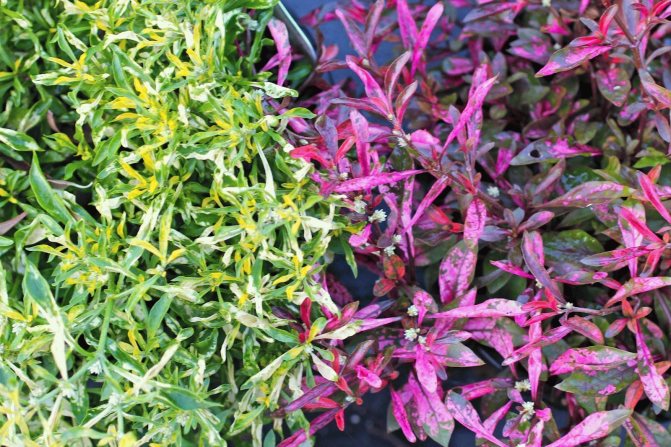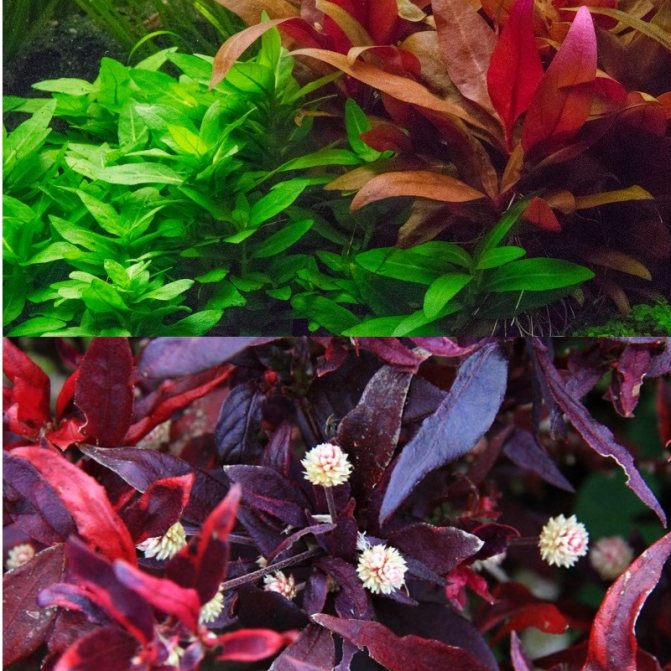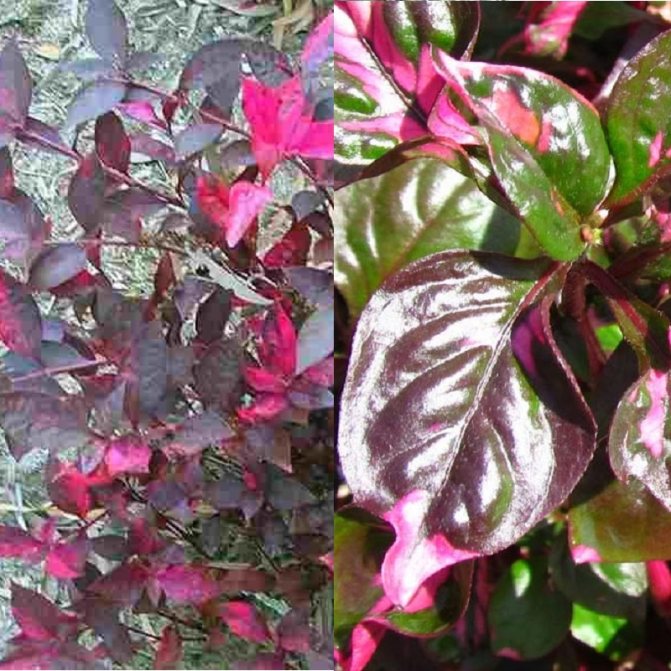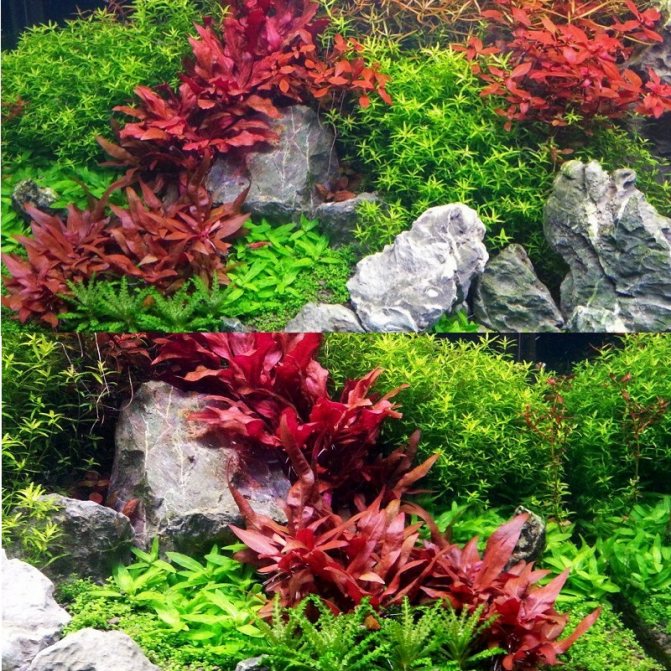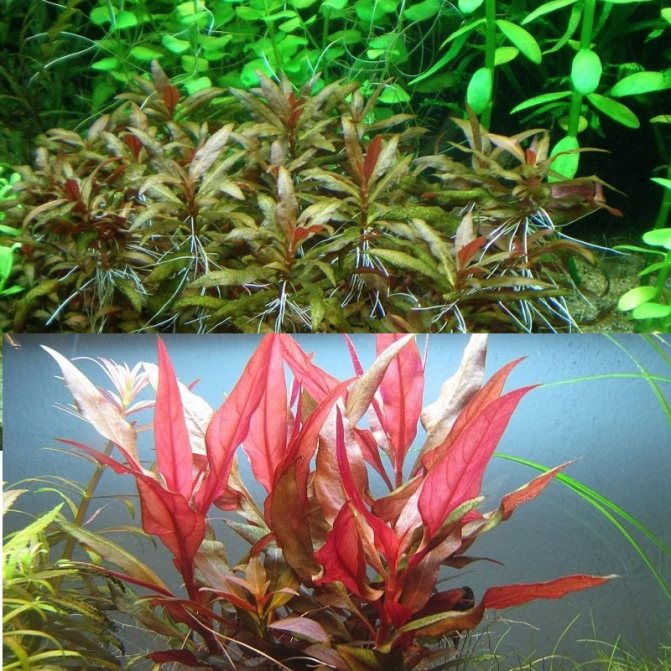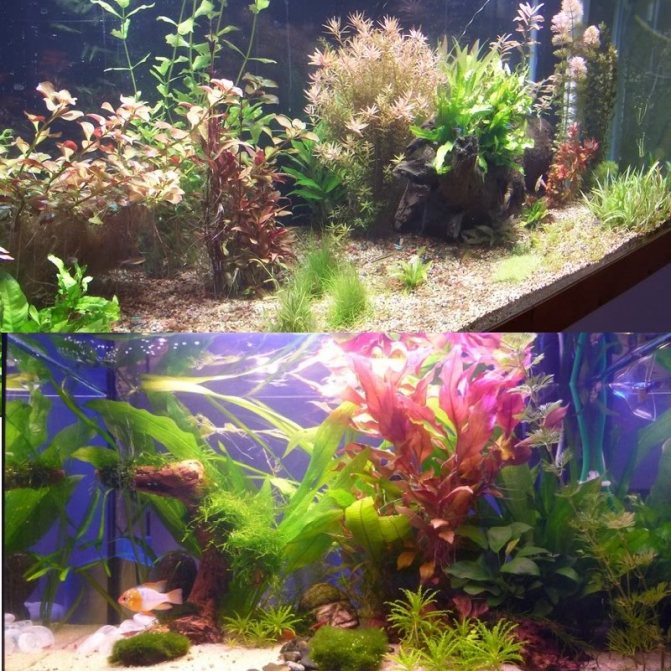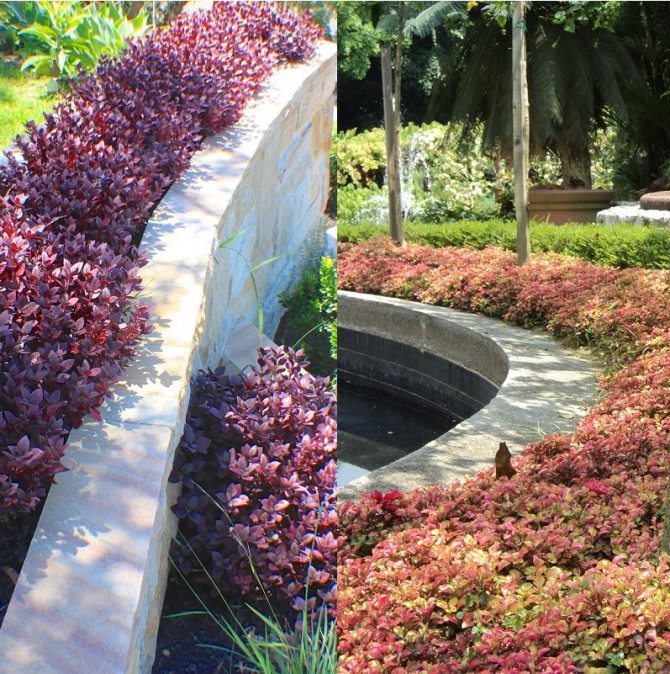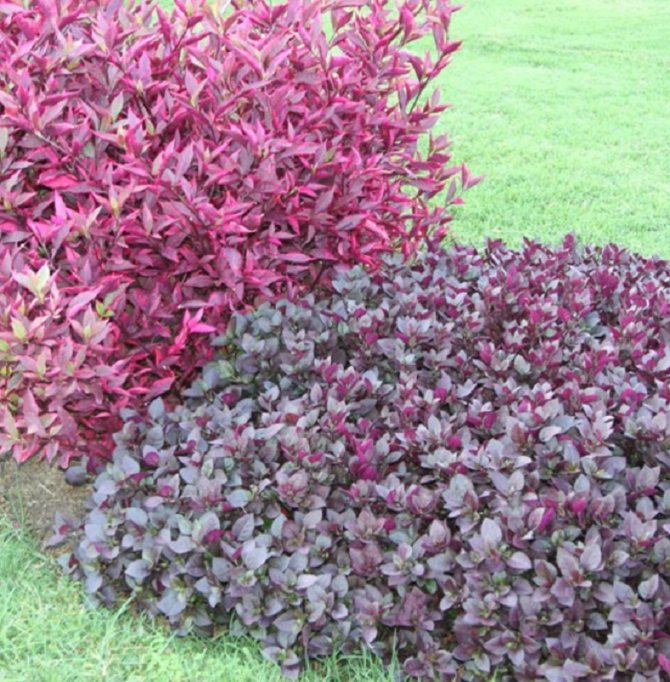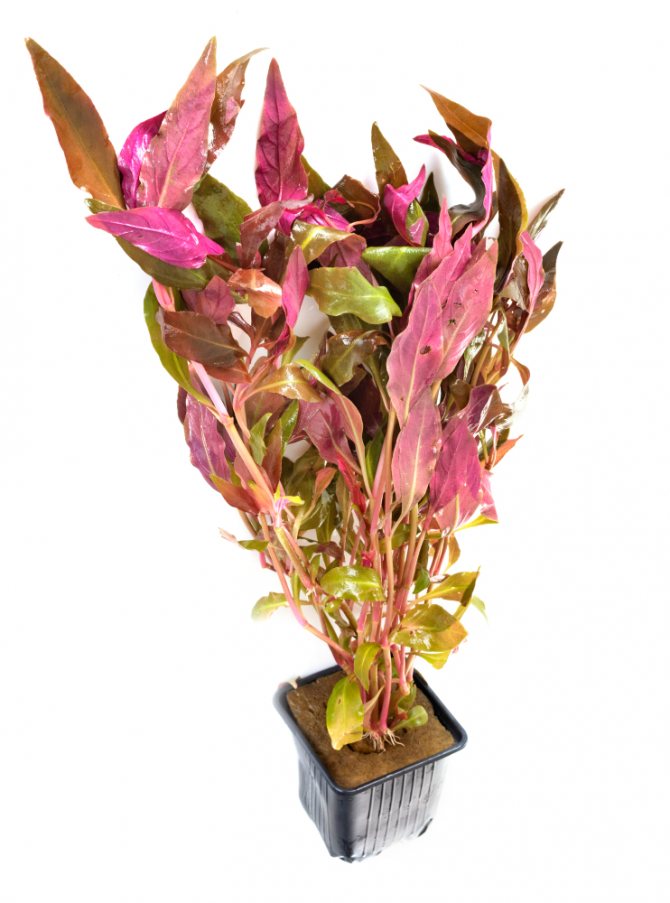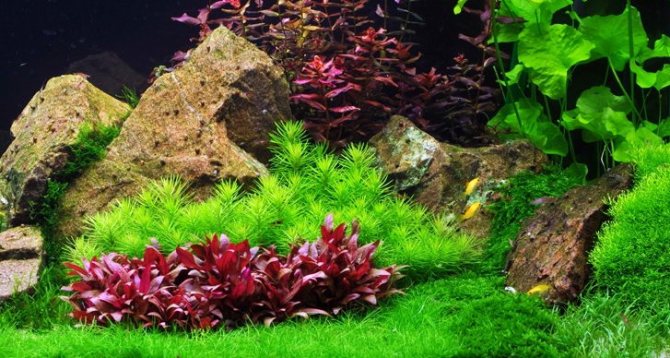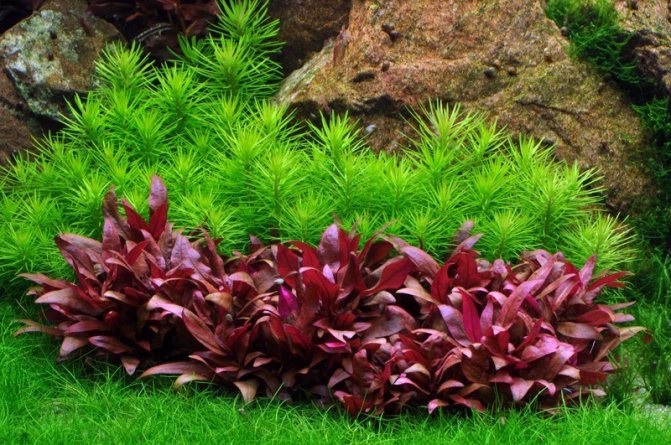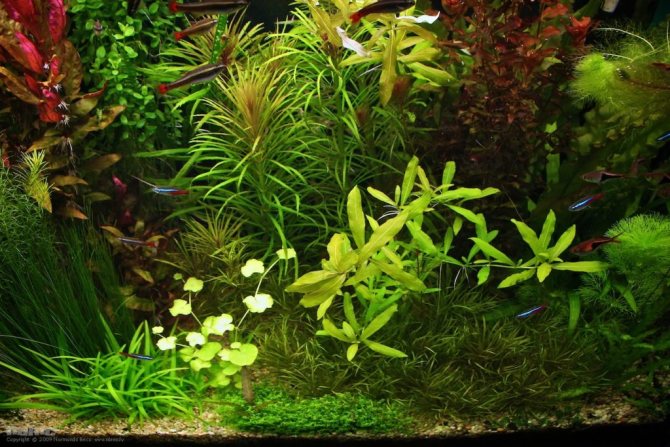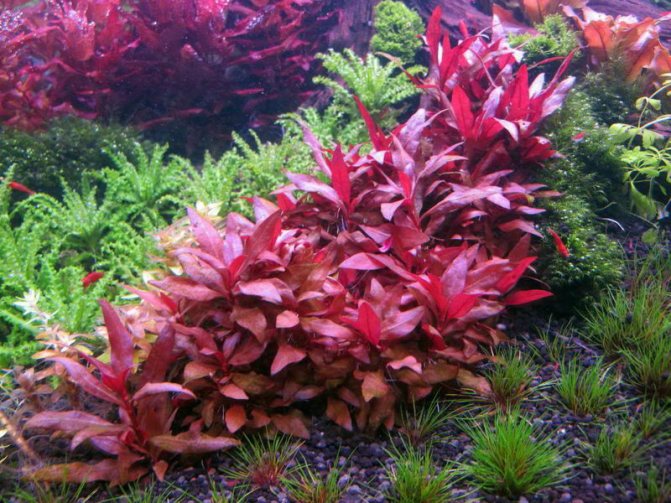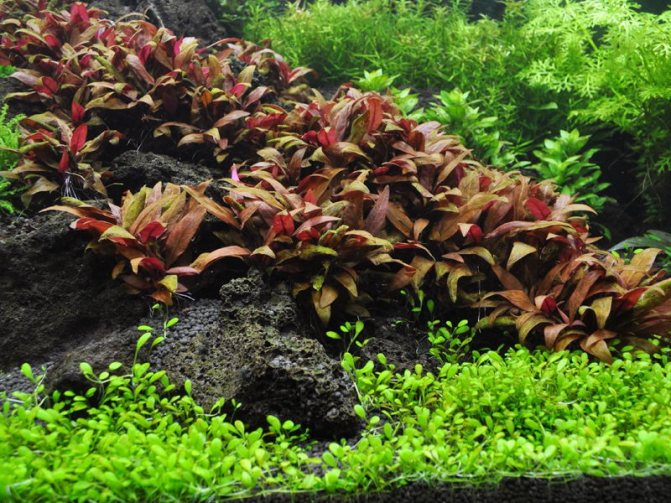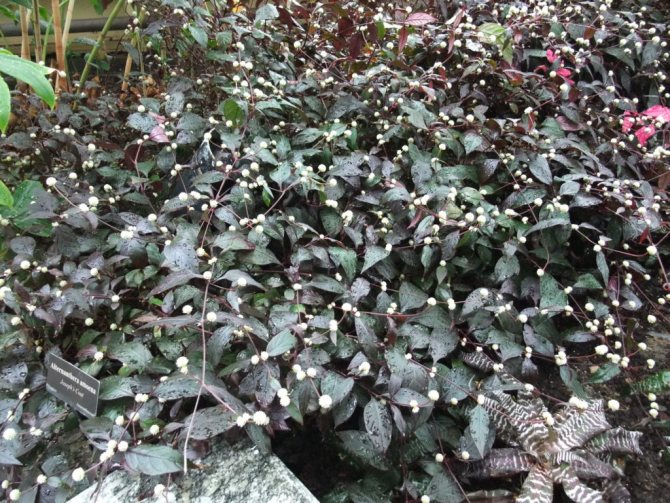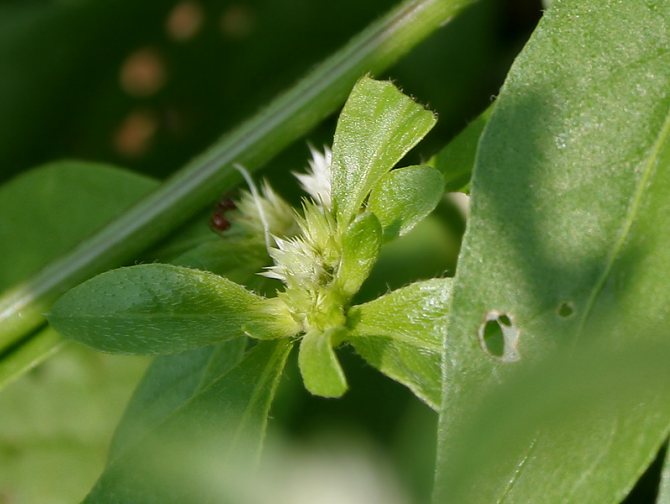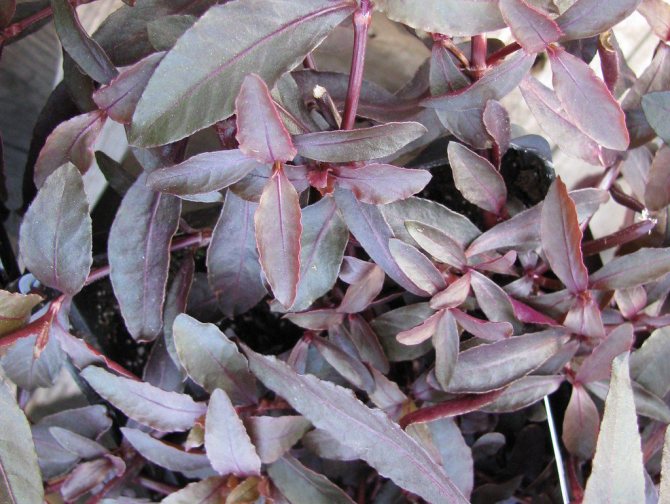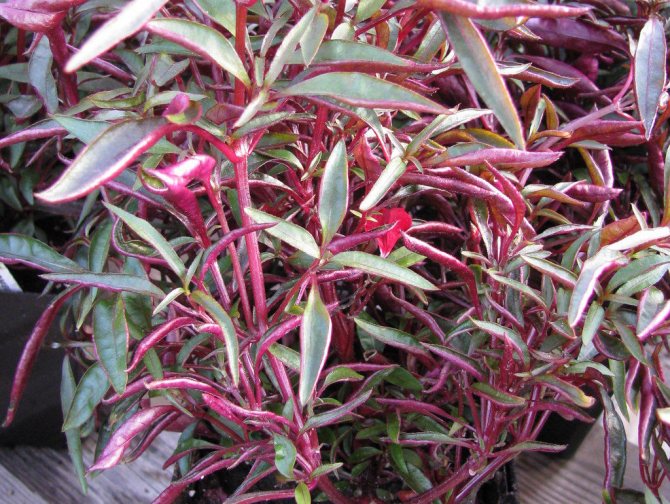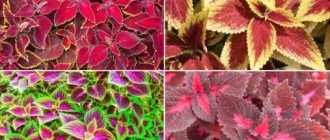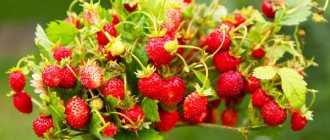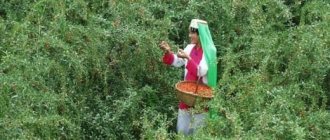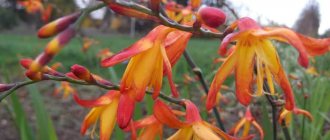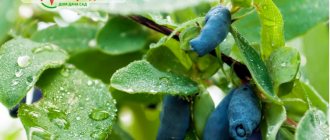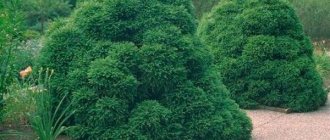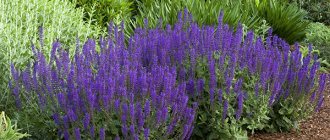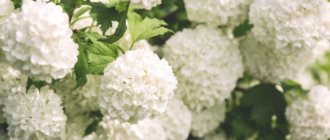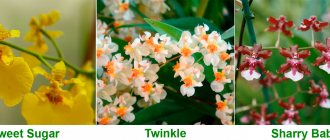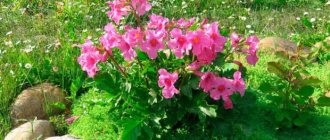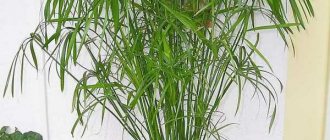Family: Amaranthaceae Continent: South America Region: South America Height: 15-40 cm Width: 10-15 cm Lighting: strong - very strong Temperature: 17-28 ° C Hardness of water: soft - medium Acceptable pH: 5 — 7 Growth rate: slow Conditions of detention: challenging In the Alternantera aquarium, lilac stands out for its color from other plants. It has elongated epileptic leaves. From above they have a rich green color, from below - a bright burgundy. The leaf plates acquire a particularly intense color when carbon dioxide is added to the water. It is best to create conditions for Alternatera under which it will be submerged in water only partially.
Above water, this plant forms beautiful flowers. Alternanthera reineckii "lilacina" needs very clean water, so it is necessary to clean the aquarium regularly, ensure good filtration and change 1/5 of the volume every week. The soil is preferable enriched with trace elements and oily. A mixture of fine sand and clay pieces works best.
Alternantera lilac loves very bright lighting and stops growing in shade. But at the same time, direct sunlight should not fall on the leaves, otherwise algae will form very quickly. Daylight hours should be 12 hours. Due to its high decorative qualities, Alternantera lilac is planted in the foreground of the aquarium in small groups.
Water parameters for optimal maintenance of Lilacin alternator in the aquarium: hardness not higher than 12 °, pH 6.2-6.8, temperature 24-28 ° C. The plant prefers old crystal clear water, so powerful filtration and weekly changes of up to 20% of the water volume are required. Afraid of algae growth.
The lighting for the Lilacin alternator needs to be bright... Fluorescent lamps of the LB type with a power of 0.5-0.7 W / l can be used as sources of artificial light. Duration of daylight hours is not less than 12 hours. Soil for Lilacin alternator is essential nutrient-rich. Reacts positively to the application of liquid complex fertilizers.
Propagated by Alternatera Lilacin by cuttings... The stem is divided into parts with 4-5 leaves and left to float near the surface of the water. The cuttings quickly develop roots, after which they can already be planted in the ground.
Alternantera Lilacin grows well in a humid greenhouse... For optimal plant growth, a nutritious soil, bright lighting and an air temperature of 26-30 ° C are needed.
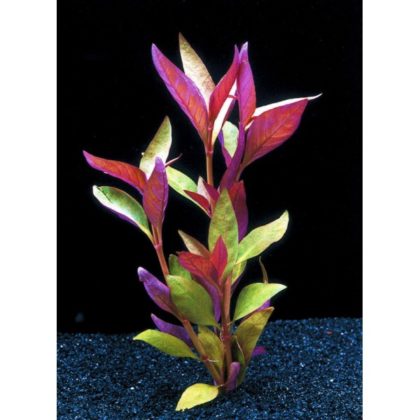
Alternatera Lilacin is rare in amateur aquariums., since it feels good not in a submerged state (in this state, the plant develops very slowly and does not form flowers), but in the above-water state. In this case, the growth rate of the plant accelerates, but still leaves much to be desired. In the aquarium, the Lilacin alternate is planted in a group in the middle ground, which enriches the color scheme of the aquarium, making it more picturesque.
Characteristic differences, description and photo of the plant
An adult plant has long shoots, sometimes reaching 50 cm. The stem is straight, long, ascending. Brownish purple in color, visually herbaceous.The leaf blade has a petiole and reaches a length of 1.5 cm. The leaves are lanceolate, ovoid, simple and opposite.
Garden Alternantera got its name for the lilac color of the back of the leaves. Above, the leaf blade is dark green, reddish green or dark olive green. Sometimes you can observe brown colors and play in the color of the leaves.
The lower, back, part of the leaf is bright purple, deep purple or even dark red.
The spread of colors depends on the depth of immersion of the plant in the water. The underwater parts of the plant will be darker and have rich characteristic colors, the above water parts are green rather than purple. Lighting also affects.
The size of the underwater plates reaches 9 cm in length and 3 cm in width. The surface parts are slightly smaller in size - 7.5 cm x 1.5 cm.
Alternantera in nature
Alternanthera Roseafolia, Alternanthera reineckii, Alternanthera Pink - all these names refer to one aquatic plant, which in Russian is called Alternanthera reineck, or Alternanthera pink.
It is ubiquitous in the equatorial and tropical latitudes of the South American continent, where it can often be seen along the banks of rivers, swamps and lakes. Plant height in the wild can reach 50 cm.
The rich flora of the tropics is very vibrant, and alternantera is fully consistent with this world thanks to its interesting coloration. The upper side of the leaves is the usual green-brown color, and the color of their lower part can be in the range of colors from pale pink to bright red-purple.
Botanists classify Alternanthera reineckii as a member of the Amaranthaceae family.
Cultivation and requirements for growth
Alternantera lilacin is a very demanding variety. Its development is slow, despite the favorable conditions and attention. Needs increased water filtration and strong lighting.
The more intense the set lighting, the better and more visible the growth of the plant. The internodes become denser, shortened, and the growth does not stretch strongly upward. If the lash is overgrown, it should be cut regularly so as not to shade the rest of the aquatic plantations in the aquarium. The required lighting parameters are 0.5 W / l.
Good light allows the purple beauty to be placed in the foreground. In low and poor lighting, the internodes of the plants become elongated, long and then it is preferable to plant them in the background.
For planting, a nutritious, rich in composition, loose soil is required. Clay soil, coarse river sand or ground gravel are also suitable. The plant responds well to regular feeding with iron and liquid fertilizers.
Important. Nutrition takes place through the rhizome and thin roots in each internode, so they cannot be removed under any circumstances!
The water where Alternantera lilac grows should have an average temperature of 25 degrees.
The temperature of water and air is preferably in the range of 22-28 ° C. These conditions must be similar to tropical conditions for successful growth and development.
For the normal process of photosynthesis, the plant requires an acidic environment with a constant supply of CO2 and maintaining the pH in the range of 6.5-7.5. Carbon dioxide deficiency will cause biogenic liming and contribute to the formation of plaque on the leaves. This plant form is especially sensitive to such changes.
Regular water changes are another cultural feature. It is required to replace at least 20% of the aquarium volume with purified water weekly. And every month to change the entire volume completely.
Alternantera feels great in a large, spacious container. It is recommended to plant plants in aquariums of 100 liters or more.
Types and varieties
A large number of species and forms of alternanter are combined into four groups:
- large-leaved tall.A striking representative of Juvel is the most attractive among large-leaved. The leaves, especially the top ones, have a carmine-red color. atropurpurea - dark brown leaves.
- Narrow-leaved undersized. Best representative A.amoena f. rosea is a short plant with carmine-red leaves.
- Narrow-leaved and curly-leaved. Example A. paranychioi - des nana compacta height about 10 cm.The leaves are brown with a red tint. A. r. aurea major (‘chroma-tclla’) - the color of the leaves is bronze-yellow.
- Broad-leaved and trileaf. Representative A. versicolor - has shiny dark purple leaves with pink-red and white spots. This species is highly responsive to cold weather and grows rapidly.
Alternantera Reineck
This aquatic plant is native to South America. Belongs to the Amaranth family. The root system is fibrous, it grows strongly. The roots are threadlike, thin and long. The bush is very similar to long grass, the stem is erect. The leaves are arranged perpendicularly, their length is 4 cm, width is 1.5 cm. The leaves have a pointed apex, tapering downwards. The cuttings are short. The color of the leaves is different: the top is dark brown with a red tint, the bottom is purple. The length of the plant is 20-50 cm.
Alternantera Reineck is considered a decoration of any aquarium. In summer, small yellow-green or pink flowers appear in the leaf axils. Being under water, the stem grows vertically upward, at a shallow depth it quickly emerges outward. In this case, the plant sheds its underwater leaves. To preserve the beautiful appearance of the underwater bush, the crown of the stem must be pinched in time. After this procedure, the plant begins to branch out, forming many beautiful bushes. The plant is fragile, but it grows rather quickly, it grows up to 10-15 cm per month. Prefers the following conditions of keeping: hardness 2-12 °, pH 6.2-6.8, temperature + 24 ... + 28 degrees. It normally tolerates a drop in temperature to +20 degrees, but growth slows down. Replaces up to 25% of the water volume weekly.
Alternantera lilac
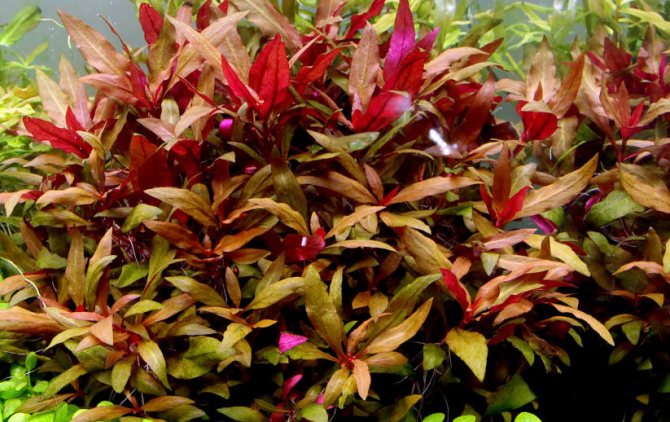

Alternantera lilac
Also Alternantera Lilatsin or Sequential anther is large. It has an erect, elongated stem. The leaves are elongated, dark green or reddish green above, dark red below. They have a length of up to 5 cm, a width of up to 2.5 cm. The height of this aquatic plant is about 50 cm. Flowers are formed at the tops of the shoots.
Alternantera sedentary
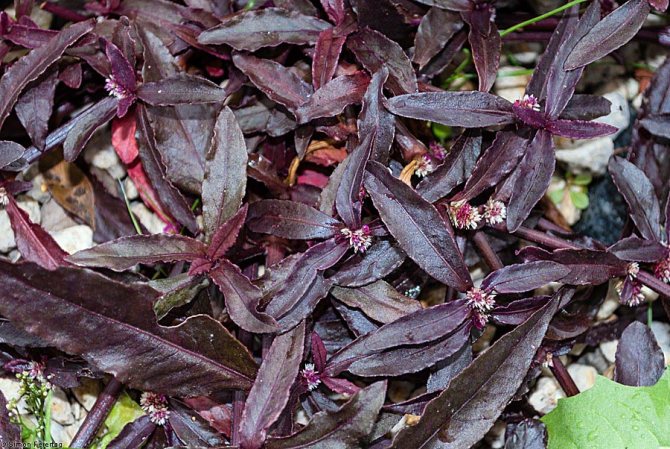

Alternantera sedentary
The homeland of this plant is the tropical reservoirs of South America, belongs to the amaranth family. The plant is not demanding on its content. Stems are long, leaves are pointed, lanceolate, arranged in pairs. The color of the leaves is brownish-green, lilac-red, pink-green shades. With prolonged exposure to light on the leaves, they turn red with an admixture of brown. The optimum temperature for uniform growth of this aquatic plant in the aquarium is + 22 ... + 28 degrees. With a decrease in temperature, the growth of the sedentary alternantera slows down. It is desirable that the water is soft, with a slightly acidic reaction. It is recommended to change the water 2-3 times a month. The color of the leaves depends on the intensity and brightness of the lighting: the more intense the light, the brighter and more beautiful the color. The root system is weak. Propagated by cuttings.
This type includes two subspecies:
Alternanthera sessilis var. lilacina - distributed throughout the world in places with warm climates. It adapts well to different living conditions - both surface and underwater. The color of the leaves depends on the growing conditions. Most often there is a green-lilac color of the leaves. Doesn't make great demands on breeding in an aquarium. Unpretentious to light intensity and water quality. When young shoots are planted, they take root well.But it is necessary to observe the only condition when growing this subspecies - to ensure the stability of the aquarium environment.
Alternanthera sessilis var. rubra. Mostly a surface subspecies. It grows at a high speed, up to 20 cm per week, while producing many leaves. When a plant is cultivated in an aquatic environment, it branches strongly, part of the stems makes its way to the surface of the water, where it begins to branch again. The stem and leaves have a bright ruby color. The flowers are colored reddish. For the appearance of flowers, a long daylight is required - up to 12 hours.
Alternantera Betzik (betzikiana)
Perennial herb, 20 cm high. Erect, pointed leaves, spatulate, drooping down. Flowers are located at the ends of the stems. Loves warmth, does not tolerate temperatures below 18 degrees. This species has varieties:
- with yellow leaves
- with the red
- with green
This Brazilian alternant has a favorite habitat in swampy bodies of water, both in water and on land. The height of the bush can reach 50 cm. The leaves can be of a wide variety of colors: yellow, olive-red, dark red, green, light yellow, pink, and may even be variegated. When growing a plant in an aquarium, it is trimmed - this is done in order to give the bush a decorative look, as well as so that the bush begins to shoot side shoots. Under good conditions, it begins to bloom with small pink flowers. Water temperature + 24 ... + 30 degrees, dH 4-12 °, pH 6.8-7, water filtration and bright lighting are required, with a day length of at least 12 hours. A weekly change of up to ¼ the volume of fresh water is required.
Alternantera betzikiana green
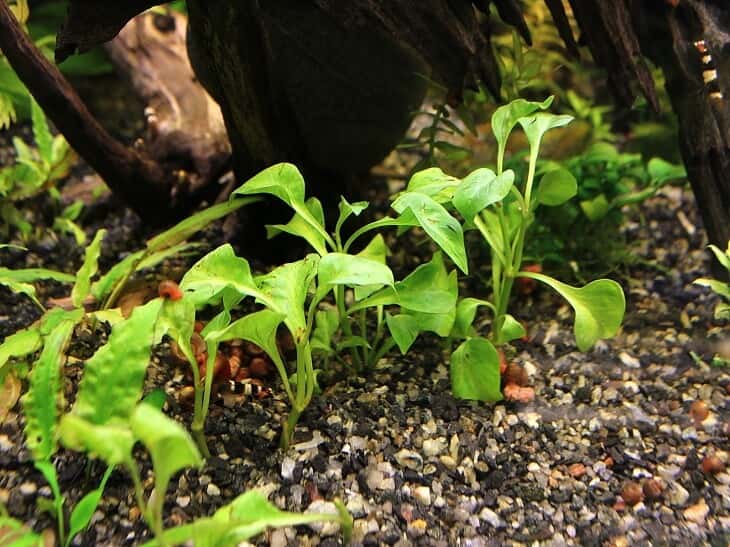

Alternantera betzikiana green
Prefers swampy bodies of water in Brazil, with stagnant water and quiet currents. It can grow both under water and in the open field along the coast. Leaves are green, boat-shaped, oblong. The bush is small, spreading, up to 15 -20 cm high. The plant must be trimmed periodically to obtain a more decorative look, in order to start the growth of a large number of lateral shoots. In good conditions, it begins to bloom with small pinkish flowers. It grows fast enough. This plant can be used both for aquariums and for decorating greenhouses. The bushes are planted at a distance of 6-8 cm from each other. Prefers temperature + 24 ... + 30 degrees, acidity pH 6.8-7.0. When the temperature drops to +18 degrees, the plant dies. A weekly replacement of ¼ part of the water in the aquarium with fresh water is required. Duration of daylight hours is 12-14 hours.
This type of alternanter loves sunlight, therefore, if possible, you should allow the sun's rays to enter the aquarium. But this must be done carefully, as you can provoke the growth of algae. The brighter the light entering the aquarium, the brighter the color of the leaves will be.
The soil should be coarse sand or a mixture of sand and fine gravel. The thickness of the soil is at least 3 cm. Pieces of clay can be placed under the roots.
Alternantera multicolor
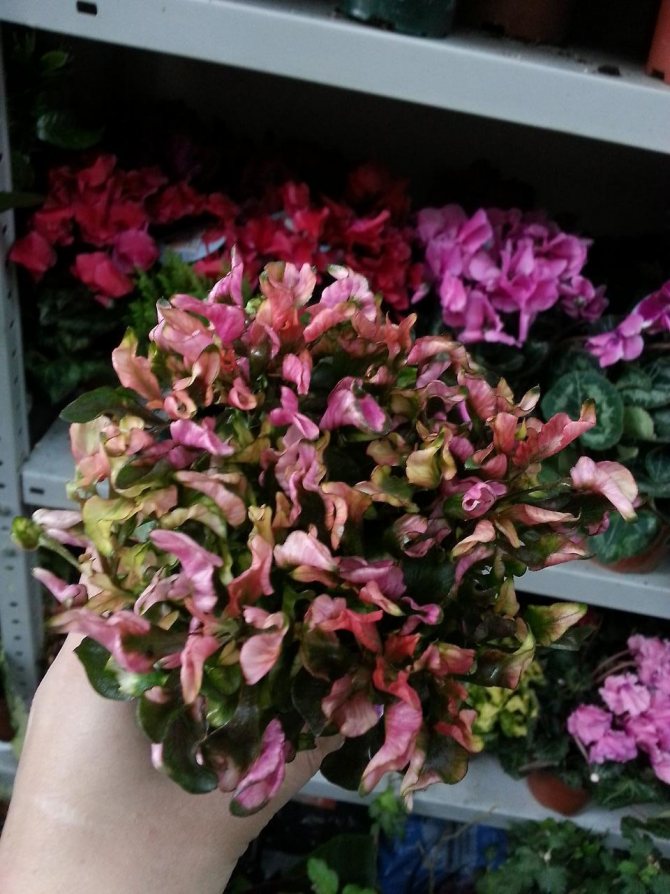

Alternantera multicolor
A multicolor alternantera comes from the tropics and subtropics of America, Africa, Asia, Australia. It is a perennial herbaceous or semi-shrub plant. Bush prone to branching at the very base. This houseplant is not whimsical to care for. Height reaches 25 cm. It has fragile stems. The leaves are small, lanceolate, opposite. The color of the leaves is very varied. Depending on the brightness and intensity of light, the color of the leaves changes its color. Plants that grow in the shade have pale green leaves. It blooms with small flowers that are located in the axils of the leaves. Flowers form capitate or spike-shaped inflorescences.
Alternantera toothed
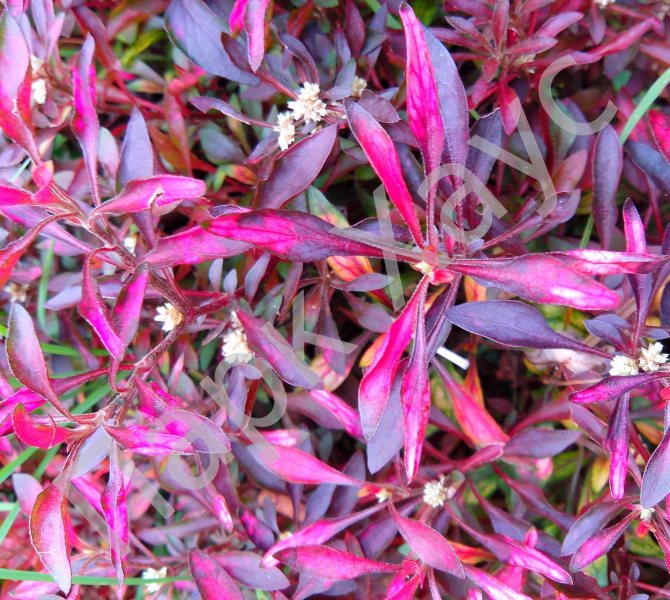

Alternantera multicolor
Does not apply to aquarium species. A plant native to South America.The leaves are dark purple in color, ovoid or lanceolate. The length of the leaves is 8-9 cm, the width is 5 cm. The height of the plant is 40-50 cm. The stems are erect, prone to branching. The small white flowers of the toothed alternantera form a capitate inflorescence, the diameter of which is 2-2.5 cm.
Alternantera water
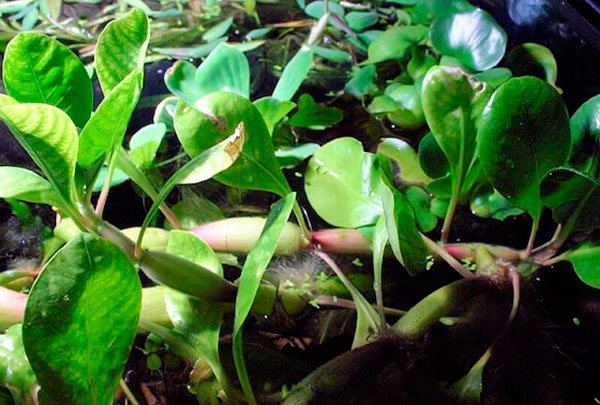

Alternantera water
The scientific name sounds like Alternanthera aquatica. It is a large floating plant. Homeland is the Amazon River basin, along the banks of rivers and swamps in Brazil, Paraguay, Bolivia, South America. The shoots are long, about 3 meters, stretching out of the water for several meters in length. Well-developed roots hold tightly to the ground or silt. The stem is hollow inside and filled with air. The leaves are green, 12-14 cm in size, evenly distributed on the stem. They have a wedge-shaped base. The petiole is about 8 cm. Roots located in the water grow under the leaves. If the stem is damaged or torn, the plant does not sink due to its interesting structure: there is a kind of partition at the place of leaf formation. It turns out a system, like a float. The plant grows very quickly, therefore, it is necessary to periodically thin out the leaves. It is quite easy to care for the Alternantera. But due to its huge size, it can only be bred in very large aquariums, which is not always possible at home. It is better to plant it in a bowl with a clay substrate. The water must contain various trace elements, potassium, phosphate and nitrates. Water temperature + 15 ... + 28 degrees, hardness dH 2-15 °, acidity pH 6.0-7.5. CO2 fertilization is optional. Requires bright lighting. The duration of daylight hours should be at least 12 hours a day. In good conditions, the water alternanter can bloom. Flowers about 6 mm, with yellow stamens and pistils, about 6 mm in size.
Alternantera purple
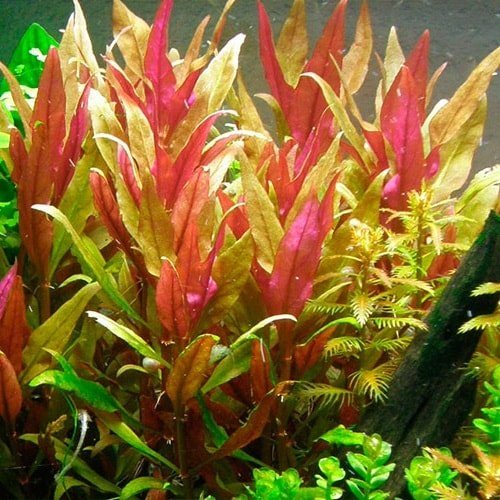

Alternantera purple
It is also called alternantera cardinalis or cardinal. The homeland of the plant is the reservoirs of South America. In reservoirs, having reached the surface of the water, it begins to grow above the water. In the conditions of the aquarium, it does not release above-water shoots. The plant is relatively easy to maintain. Among other aquarium greenery, it stands out brightly due to the color of its leaves: the bottom is bright red, and the top is green. The leaves are wavy, lanceolate. The maximum height of the bush is 40 cm. The adaptation of the plant in a new place takes about 2 weeks, then it begins to grow rapidly. Acceptable temperature + 20 ... + 26 degrees, hardness dH 2-4 °, acidity pH 6.3-7.5. The quality of water is demanding: it is advisable to replace part of the water in the aquarium twice a week. In poor quality old water, plant development slows down. He loves bright lighting, because the color of the leaves and the overall appearance of the bush depend on the brightness and duration of the lighting. Even in the matter of lighting, it is necessary to know the measure, since if the norm is exceeded, algae may overgrow the leaves, which can lead to the death of the plant.
Alternantera lilac or large anther
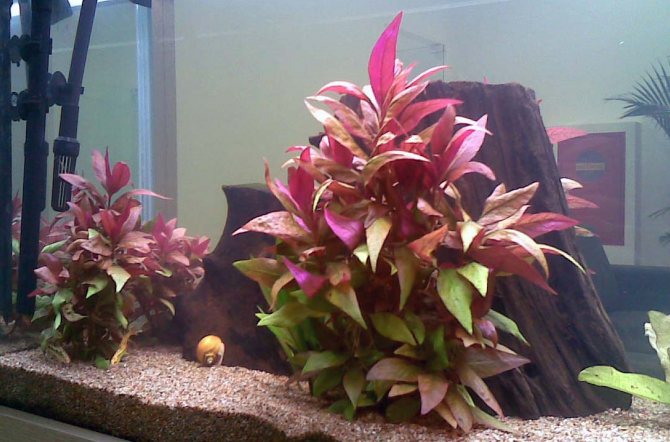

Alternantera lilac or large anther
Inhabits quiet, with a small current, water bodies of South America. Outwardly, a very beautiful plant. Against the background of other greenery in the aquarium, it stands out strongly with its bright color of the leaves. They have an elongated elliptical shape. They are located opposite each other. Above, the leaves are red-green or dark green in color, and below they are burgundy. The length of the leaves is 5 cm, the width is 2 cm. In the part of the plant, which is located above the water, flowers are formed. In aquariums, the height of the alternate anther can reach 50
Alternantera red
Grows in swampy waters, along the shores of lakes and rivers in South America. It got its name from the bright red color of the leaves. The stem is erect, 20 cm high.The leaves have a small stalk, the shape of the leaf plate is simple, sessile. It grows slowly. Under good conditions, the plant blooms - releases surface shoots. The flowers are small and unsightly in appearance. With its color, this plant is very beautiful, it stands out in the aquarium against the background of green vegetation.
Alternantera mini
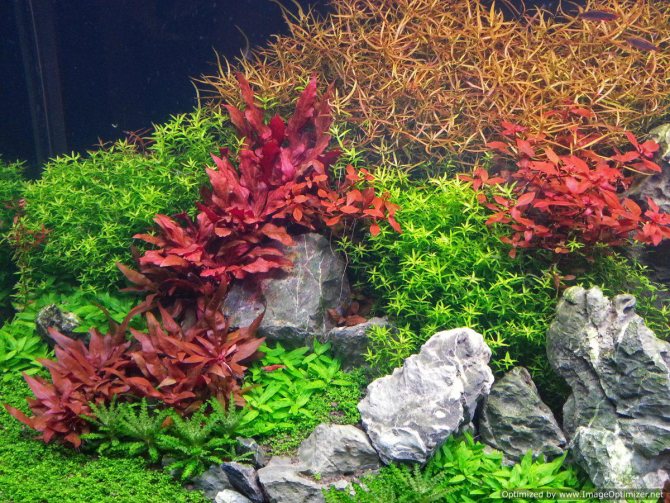

Alternantera mini
The plant is red, undersized. It is a dwarf form of the Reineck alternantera. She became famous in Europe in 2007. The length of the stems is no more than 20 cm. Many lateral shoots extend from it to the sides. Maintenance requirements are in many ways similar to the Reineck alternator: moderate illumination, water temperature + 22 ... + 28 degrees. The growth rate is low. You can propagate by shoots or by dividing the bushes.
Alternantera adorable or sweet
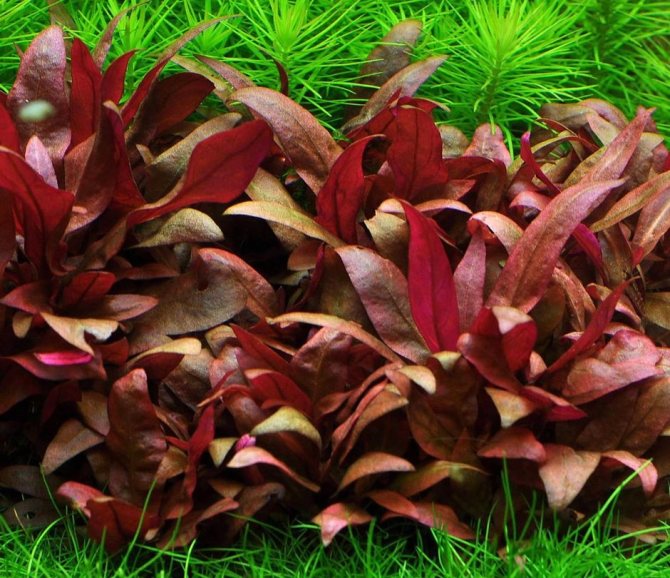

Alternantera adorable or sweet
The homeland of this plant is Brazil. Perennial herb of the Amaranth family. Grown in the open field. It has a small height, about 15-25 cm. The stem may have a few shoots on the sides. The leaves are small, oval-shaped. Leaves can be green, burgundy and red-orange. Flowers are small, located at the ends of the shoots. Prefers a temperature of + 18 ... + 28 degrees, in winter + 10 ... + 15 degrees, medium moisture soil. Loves feeding with mineral and organic fertilizers. Propagated by cuttings. The adorable alternantera is a charming plant that looks great in compositions against a background of green plants.
Alternantera Splendida
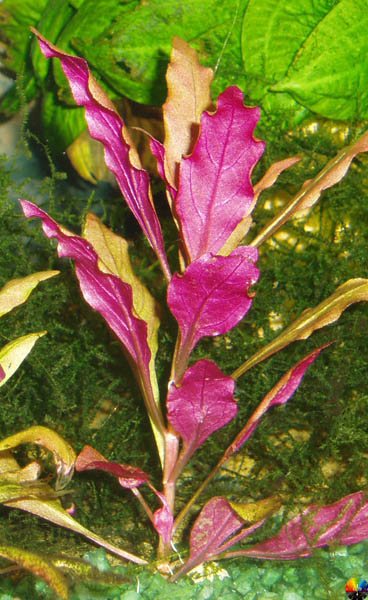

Alternantera Splendida
The plant is distributed along the banks of rivers, lakes and swamps in the tropics of South America. The stem is erect or creeping. Height is from 20 to 40 cm. Fans of the aquarium business rarely breed this species. A lot of light is needed for growth and bright colors. Loves iron feeding. Temperature range + 22 ... + 30 degrees. The color of the leaves depends on the lighting power and the quality of the water. On both sides, the leaves are pink, red, or even purple-red.
Alternantera pink
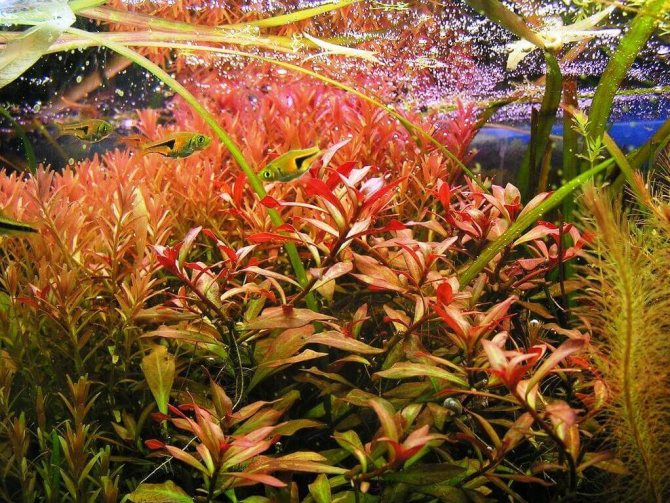

Alternantera pink
The homeland of this aquarium plant is South America. A very beautiful bush with a long stem and leaves, with a color from pink-red to dark purple. Long lashes spread along the surface of the water, are pink in color. When the lashes grow, they rise above the surface of the water, and, as they grow, begin to sink into the water under their own weight. An alternant that is completely under water grows very slowly. This species is not very popular among aquarists. Prefers water temperature + 24 ... + 28 degrees. It tolerates a decrease in temperature to +20 degrees, while growth slows down. Needs periodic water refreshing.
Alternantera garden, form "Osiris"
The breeding material was collected in the tropics of Brazil. The stem is erect, long, herbaceous, green. The weak root system consists of one lobe of white thin roots. Leaves are simple, petiolate, opposite. Petioles are shorter than leaves. The color of the leaves is different - the top is pale green with a yellow bloom, the bottom is green, sometimes with a raspberry bloom. The length of the leaflet is related to the width of 2: 1.
Principles of growing shoots
Adequate care and adherence to the necessary standards guarantees good growth of shoots from which new young plants can be grown. Reproduction takes place by cutting the shoot and rooting it in the usual water conditions.
A somewhat complex, but the existing method of propagation by leaves, will require more time. It is recommended to use root-forming solutions for fast and guaranteed development of the root system.
But the method of cuttings is used more often and gives a better chance of obtaining a finished plant with a good root.
The appearance of the first roots on the cuttings signals the need for transplanting into the ground.Difficulties in the question of how to plant young shoots should not arise. For a quick build-up of mass, the plant can be planted closer to the surface of the water.
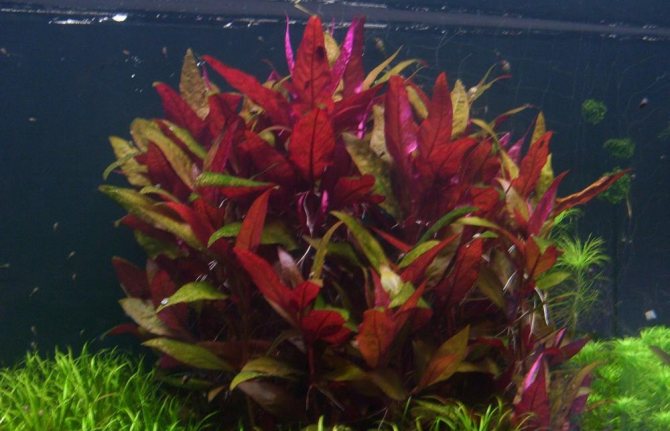

Cuttings are the best breeding method for Alternantera lilac.
Planting and breeding
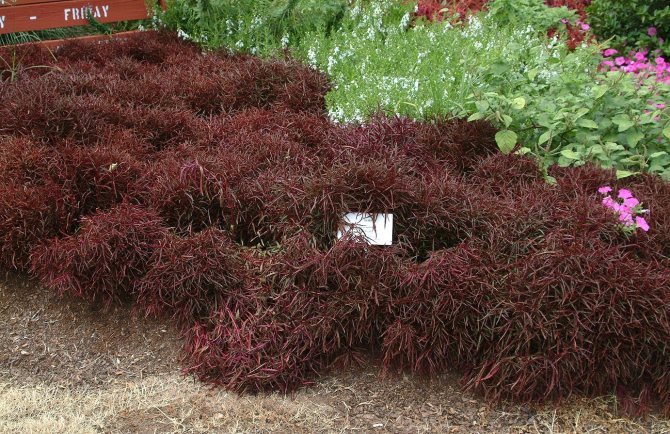

Priming
In an aquarium, the soil is not so important - they usually buy ready-made mixtures that are already intended for aquarium plants. But the addition of coarse sand has a good effect on plant growth.
Reproduction
There are two ways to grow a new plant:
- seed;
- vegetative (cuttings and division of the old bush);
The seed method is laborious, because quite often, alternantera do not form flowers. The second method is most widespread.
Cuttings - Cuttings are cut in advance in the fall. And they plant them in the ground. The container must be covered with plastic wrap, placed in a lighted place without direct sunlight. Dig in the cuttings to the first leaf, provided that the length of the workpiece must be at least 8 -10 cm and have 8 leaves. Next, you need to water the soil and ventilate. When the first new leaves appear, the film is removed from the container. As soon as it can be seen that the cutting has begun to grow actively, the tops of the shoots need to be pinched. This will encourage lateral shoots to appear. The workpieces can sprout after 8-10 days. In late spring - from May, when the night frosts cease, the plants are transplanted into open ground. To obtain a more lush and beautiful bush, several seedlings are planted in one hole. If you want to grow a plant indoors, then a small pot is selected for seedlings.
When alternanthera reproduce in aquarium conditions, the torn off stalk is simply left to float on the surface of the water. After a short period of time, the roots will appear, and then you can plant the bushes in the substrate.
Acceptable neighborhood with fish
Any aquarium will not be a beautiful decoration without vegetation in the water. And aquarium fish love not only to hide behind leaves, but also to bite off or break off them.
The fragile leaves of Alternanthera will be in danger next to adult ancistrus and similar large fish. A damaged plant will have a spoiled appearance and may stop growing.
To select fish in the neighborhood, it is important to correctly calculate the ratio of fish and plants in the aquarium. After all, the lack of swimming will also negatively affect the development of the lilac beauty.
Plant care
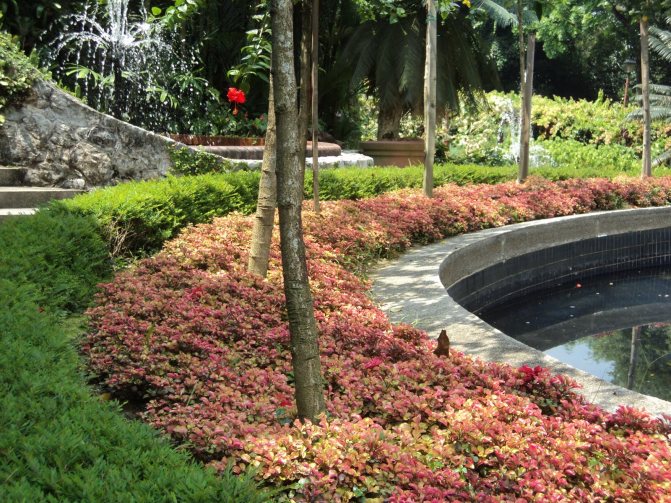

A feature of alternantera is that it can be grown both in a pot at home and in an aquarium. Caring for her is simple, but there are rules:
- There should be bright lighting. The brighter the light, the more intense the color of the leaves. With a lack of light, the leaves will turn green and pale.
- The air temperature in summer is + 24 ... + 28 degrees, in winter + 15 ... + 17 degrees.
- High humidity is desirable. Only at high humidity does the Alternantera begin to bloom. Most often, flowering occurs when the plant is grown in an aquarium.
Development cycle
The life cycle of development is understood as ontogenesis - the individual development of a plant from the moment of the formation of a zygote to the withering away of the aboveground and underground parts. In horticulture, a group of plants is distinguished, which is called "letniki". Alternantera is a perennial herb cultivated as annuals.
The soil
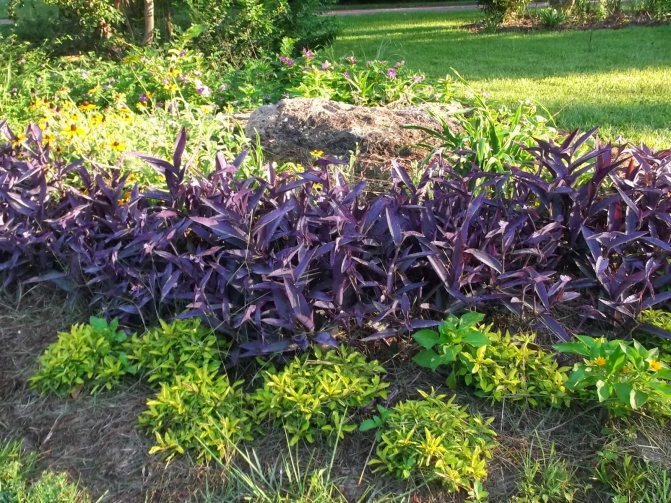

When grown outdoors, Alternantera does not like loamy areas, shaded areas, poor soils. Prefers nutritious, moisture and breathable, neutral acidic soils.
When breeding a plant at home, you should use a greenhouse mixture enriched with humus, a mixture of peat with garden soil and clean sand (all in equal parts), as well as turf, sand, humus and garden soil with a lot of last year's foliage (all in equal parts) ...
Watering
If the alternantera is grown in an aquarium, then naturally it does not need watering.But it is necessary to periodically replace the water with fresh water, since in the old stagnant water the plant begins to grow very slowly.
When growing a bush at home, for example, in a pot, watering should be moderate. Watering is necessary when the top layer of the soil dries up, with warm water. Excessive moisture in the soil can lead to rot.
Lighting
When breeding a plant in an aquarium, bright lighting is necessary, since the color of the leaves directly depends on the quality of the lighting. It also loves direct sunlight, but it is preferable to use artificial light, use LB-type lamps. You cannot take incandescent lamps of large power, as they can form burns on the shoots, which will stretch, rise above the water surface. Duration of daylight hours is 12 hours.
What and how to plant
A well-planted underwater garden allows you to rest your soul, watching every movement of a leaf and the movement of a fish. However, it is impossible to plant everything and launch absolutely different fish.
Good neighbors can be:
- Peplis (Didiplis diandra);
- Fern Azolla (Azolla filiculoides);
- Escaping limnobium (Limnobium laevigatum);
- Swimming phyllanthus (Phyllanthus fluitan);
- Beautiful Eichhornia (Eichhornia crassipes);
- Eichhornia azurea (Eichhornia azurea);
- Swimming Ludwigia (Ludwigia helminthorrhiza).
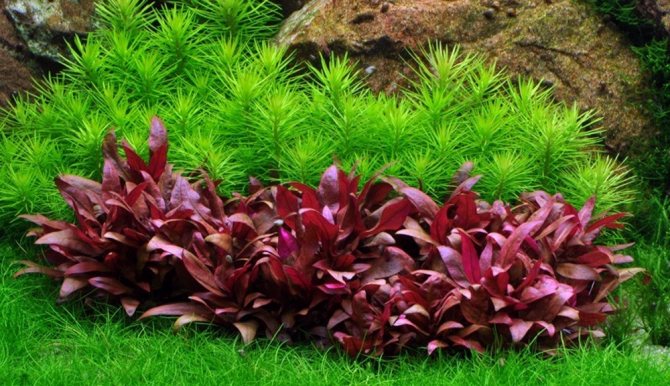

Alternantera lilac is combined with many aquatic plants.
Each plant species has its own characteristics in planting and development. Keeping Alternantera as a decoration for such a garden requires careful and intelligent placement and community with other plants.
Description
All alternanater plant species are herbaceous perennials or dwarf shrubs, but are used as decorative leafy annuals. The flowers are inconspicuous and small, with no decorative value. The alternater plant looks like a spreading, low bush, which becomes more bushy after shearing.
Of all the species, only the sedentary alternantera (A.sessilis) is ideal for decorating a pond. The rest of the species are spreading, low bushes up to 25 cm high. Due to this decorative effect, Alternantera is considered the main crop among all existing carpet plants. The alternanter plant in landscape design is used as a ground cover plant.
Aquarists' recommendations
If you have chosen lilac Alternantera for your aquarium, then plant it not as an adult plant, but with a stalk of 3-5 internodes. Such a plant is guaranteed to take root quickly and will not stop growing. The only exceptions are adult plants from your own aquarium.
Alternantera grows slowly and requires certain conditions of detention. In order for it to grow a healthy and strong plant, fluctuations in the acidity of the water and in the quality of lighting should not be allowed. Sharp jumps in stiffness and disruptions in the supply of carbon dioxide. Any disturbance can cause stunted growth or even shedding of foliage and fouling.
In the video, the specialist shows the aquatic plant Alternantera lilac and talks about it.
Fight against possible pests and diseases alternantera
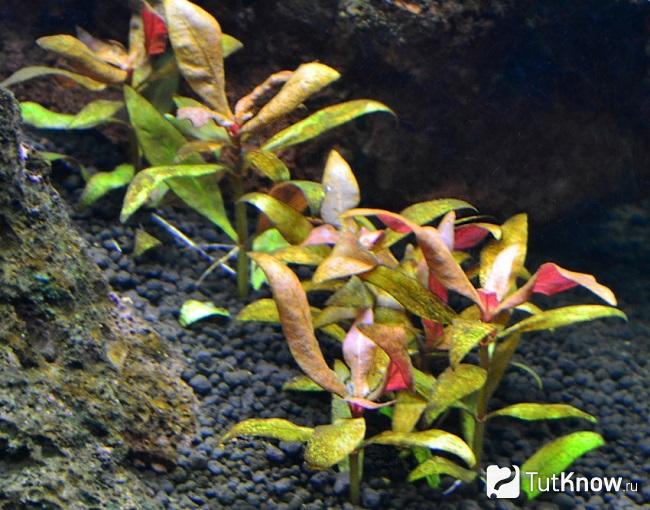

The plant is quite resistant and does not undergo diseases or pest attacks. But still, with frequent violations of the conditions of detention, it can be affected by gray rot, especially if this representative of the flora is grown as a pot culture. Such a nuisance happens with high soil moisture. To cure it, it is recommended to remove all affected parts of Alternanthera, and then treat the bush with fungicidal agents. It can be copper sulfate or similar drugs with a similar effect.
From harmful insects that harm the alternate, spider mites, aphids or whiteflies are isolated.If signs of damage are detected (whitish specks on the back of leaves or white midges, cobwebs on leaves and twigs or small greenish bugs), it is recommended to treat with insecticidal preparations with repeated spraying after a week.
Lighting state
Without bright light, the tropical Reinek alternant will drastically slow down its growth and may even die. That is why it should be illuminated regularly, at least 12 hours a day without interruption, using medium-power fluorescent lamps.
Such light sources must be located at a distance of at least 25-30 cm from the surface of the water, since, otherwise, the upper tender leaves of the plant may receive a thermal burn.
Such lighting requirements exclude the permissibility of breeding shade-loving aquatic vegetation with the pink beauty.
Alternanthera sessilis
Amaranth family - Amaranthaceae. Distributed throughout the tropical region of the Earth.
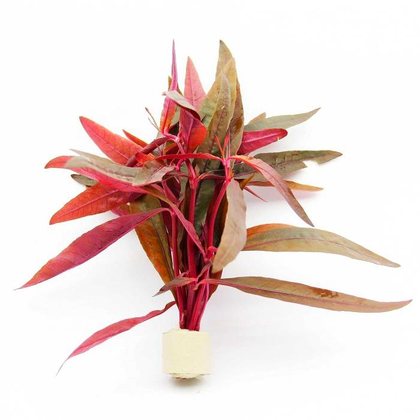

A relatively undemanding long-stemmed plant, very popular due to the beautiful color of the leaves - from pink-green to purple-red. It grows well both in a deep aquarium and in a humid greenhouse. It grows evenly under water throughout the year.
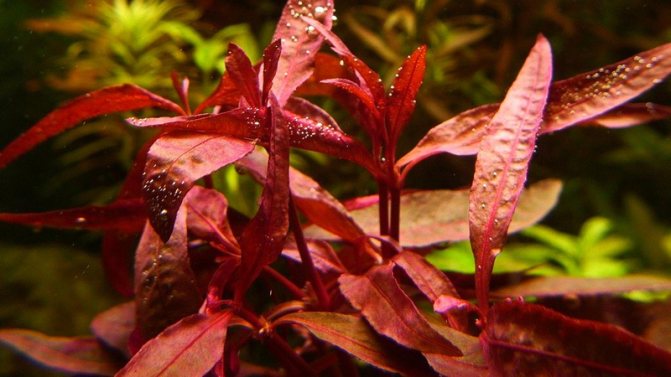

Alternantera feels good at water temperatures from 22 to 28 ° C. In colder water, its growth slows down sharply. The hardness and active reaction of water do not significantly affect the state of the plant, however, soft water with a slightly acidic reaction is more preferable. In it, the alternantera develops somewhat faster. It is necessary to change up to 1/5 of the volume of water 3-4 times a month.
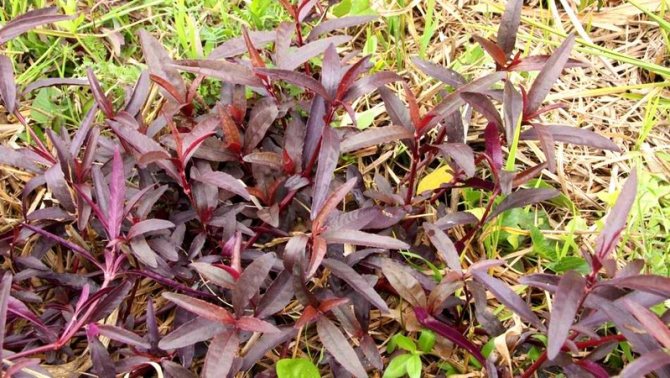

The lighting should be bright enough. The color of the leaves depends on its intensity - the brighter the lighting, the more red tones prevail in it. Both natural and artificial lighting are suitable for alternantera. For artificial lighting, a combination of incandescent and fluorescent lamps is preferred. Fluorescent lamps of the type LD should not be used, since the spectrum of the light emitted by them does not quite suit the plant.
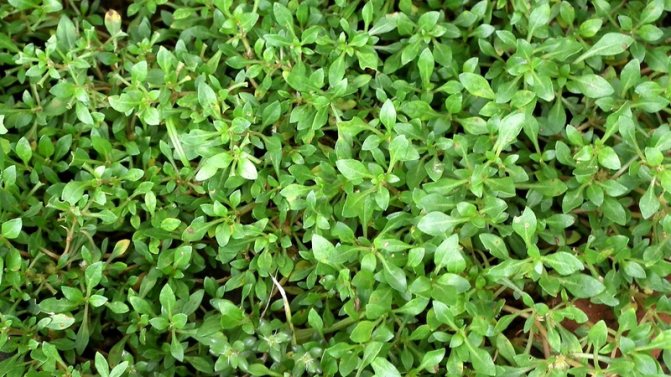

The root system of the alternantera is poorly developed, so the nature of the soil does not play a significant role for it. Any substrate can be used, but plant roots develop better in coarse sand. Silt should be moderate or light. The thickness of the soil layer in the aquarium can be any, even a two-centimeter layer of sand is quite enough for the satisfactory growth of the alternantera.
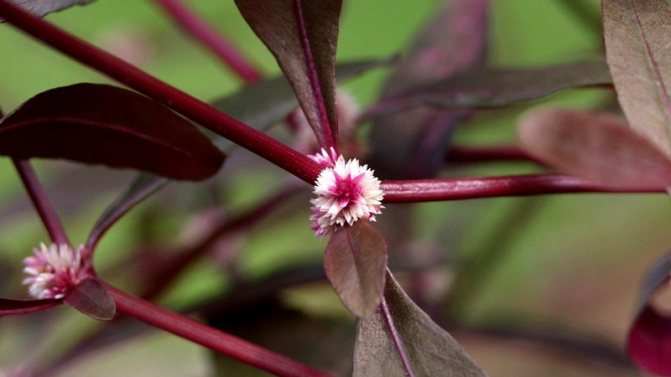

Alternantera sedentary reproduces very easily by cuttings. Long stems that reach the surface of the water must be shortened by removing the top, which is planted directly into the ground, deepening the lower whorl of the leaves. After a few days, the plant will develop roots. Long stems can be divided into several parts, and each cutting should have 3-4 whorls of leaves. It can be planted immediately into the ground, without leaving it on the surface of the water and without waiting for roots to appear in the leaf axils. Cuttings left to float grow worse than those planted in the ground.
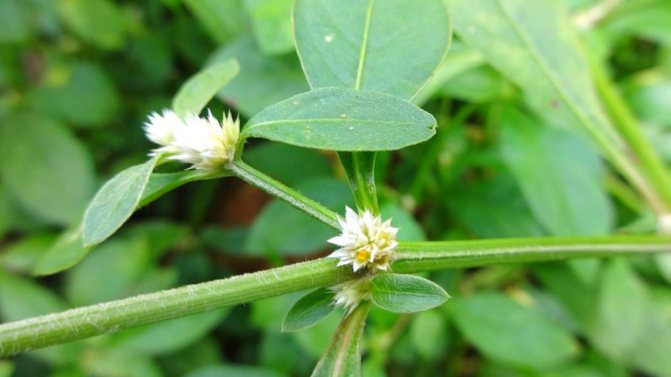

In a humid greenhouse, the sessile sessile grows noticeably faster, but loses its attractiveness to a significant extent. It is necessary to gradually transfer plants from an underwater form to an aboveground one. When planted in a shallow aquarium, the plant easily forms aerial shoots that can be detached and planted in flooded or very moist soil. In a greenhouse for this plant, you can use garden soil, a significant part of which is sand and peat. The temperature of the water (soil) and air should be within the range of 26-30 ° C, the lighting is very bright. A terrestrial-raised Alternantera tolerates flooding very easily. The plant can be planted almost painlessly in the soil of a deep aquarium, where it will continue to grow after a short time.
Alternantera is a perennial plant that is more commonly grown as an annual.It is appreciated for its unpretentiousness, decorative leaves.
It reaches a height of up to 20 cm. The flowers are not decorative, since they are very small and inconspicuous. In addition, Alternantera rarely blooms. There are more than 200 species in the genus, some of the species (A. Reineka) grow exclusively in water and are often used for landscaping aquariums.
Useful video
In the video below, you will learn about growing and caring for Alternantera at home:
There are many other, no less beautiful plants, the care of which also requires some effort, but the result will certainly please you. Read about the cultivation of evergreen Metrosideros, the never-fading charm of Gomphrena Globular, the "golden tree" of the Japanese Aucuba, the luxurious Caladium, the beautiful Dizitogoteka, the exotic Taro, the amazing Leptospermum, the unusual Koufei, the Anredera room creeper and the lovely Mühlenbekia.
Pests
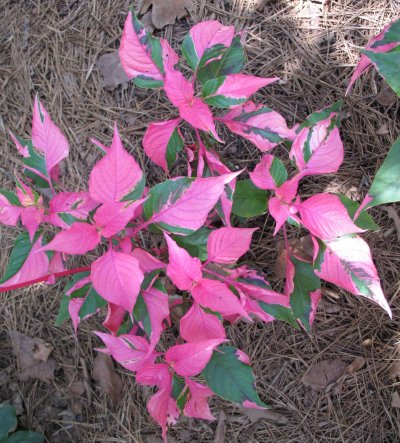

Spider mite (identified by the presence of a large number of cobwebs between the leaf and stems).
Control methods:
- trimming the affected areas;
- spraying the plant and frequent wet cleaning on the windowsill (for potted specimens);
- acaricide treatment;
- spraying with a decoction of orange peels (preventive measure).
Whitefly (small butterflies with a white pair of wings). Control measures - insecticide treatment.
Aphids (a cluster of small green insects) - the foliage dries up and curls up, the plant stops developing. Control measures - insecticide treatment.
Wintering
Perennial varieties require special care in winter. Good illumination is an important condition for keeping. With a lack of sunlight, the culture should be placed under artificial lamps.
The temperature for keeping alternantera in winter should be no more than 18 degrees. The optimum temperature is 14 degrees.
In winter, the culture stops growing, it does not need a lot of water. Therefore, when grown indoors, watering is reduced to 2 times a week.
Alternanthera sedentary (Alternanthera sesilis)
The process of adaptation to water conditions does not interfere with the falling of the lower leaves, since new decorative bushes are formed at the same time. When the aquarium is well lit, the top of the leaf is usually green, the bottom light green or pinkish; in partial shade or shaded areas - olive brown and violet red, respectively. But, unfortunately, this plant has a less intense red color than other alternanter species cultivated in our country. It grows equally well in shaded areas and in direct light. Planted in the aquarium are sufficiently mature, well-formed stem parts that have at least four pairs of leaves. This is the only species of the genus that reproduces rather quickly under water, forming powerful bushes. Groups of 10-15 plants look the most attractive. They are good for decorating the back walls of small aquariums. In large species aquariums, alternanter groups are located in the middle in free places, where they form islets with an area of 20-30 square centimeters. The sessile alternatera is characterized by the fact that in the terrestrial form it has a dense, highly branching stem, and in conditions of low humidity, it creeps. Seeds are small, whitish.
Alternanthera sessilis var. lilacina
found in warm areas around the globe. This plant adapts well to different forms of existence and can grow both under water and on land. The color of plants is highly variable and depends on the cultivation conditions. Usually the top side of the leaf is olive green, the bottom is dark red to purple. But sometimes forms appear in which the leaves on both sides are painted in an intense red color. In the middle lane, the plant can be successfully cultivated in the open field in summer.To be kept in an aquarium, this alternantera must be grown in conditions of high air humidity (85-95 percent) of a tropical paludarium at a temperature of 20 to 30 ° C. Young, not yet flowering shoots when planted under water easily root and die relatively rarely. The plant is insensitive to the chemical composition of water, tolerates both partial shade and excess light equally well, the optimal pH of the water is about 7. The basic rule when growing this alternantera is to create fairly stable conditions in the aquarium. It grows well in crystal clear water without algae.
Alternanthera sessilis var. rubra
- the plant is emergent and is well cultivated in a humid paludarium. It grows very quickly: in 3-4 weeks the stem reaches a length of 15-20 centimeters with a large number of leaves. The underwater form forms branched creeping stems above the ground, and only a third of them straightens and also begins to branch strongly near the water surface. In general, they reach a length of 50-60 centimeters. Leaves are opposite, 3.5-5.0 centimeters long and 0.8-1.7 centimeters wide. They are ruby red on both sides. The stem is also red.
Pressed by a pebble to the ground, it forms a large number of white roots in the place of an independent pair of leaves and takes root easily. The flowers are completely sessile, red or pink; they appear in the axils of the opposite pair of leaves. Since this plant comes from the tropics, it begins to bloom during the equinox, when the light is 12 hours a day, that is, it has the length of a tropical day. In an aquarium, these plants are usually planted in groups of 3-5 or more shoots. The most suitable place is in the middle part of the reservoir, where they are placed in front of taller green and yellow-green plants. Under water, they take root in ten days, but later they grow ns as fast as in the paludarium, and retain their decorative appearance well for 2-6 months. When the leaves begin to fall off, the plants should be replaced with new ones. To do this, you need to have an additional greenhouse, growing new adult plants from cuttings in it, which need the maximum possible air humidity and diffused lighting. In aquarium conditions A. sessilis var. rubra needs good lighting and slightly acidic water.
Alternanters are amazingly beautiful plants that decorate decorative aquariums. They also look great when cultivated in open reservoirs of garden plots, where it is possible to create compositions with both aquatic forms and those that emerged to the surface of the water and rooted in coastal soil.
All of the above is just the fruit of observing this type of aquarium plant and collecting various information from owners and breeders. We would like to share with visitors not only information, but also living emotions
, allowing you to more fully and subtly penetrate the world of aquarium hobby. Register on, participate in discussions on the forum, create profile topics where you will talk about your aquatic organisms in the first person and firsthand, describe their content features, share with us your successes and joys, share experiences and learn from the experience of others. We are interested in every part of your experience, every second of your joy, every realization of a mistake, which makes it possible for your comrades to avoid the same mistake. The more we are, the more pure and transparent droplets of goodness in the life and life of our seven-billion-dollar society.
Alternanthera lilac Alternanthera lilacina
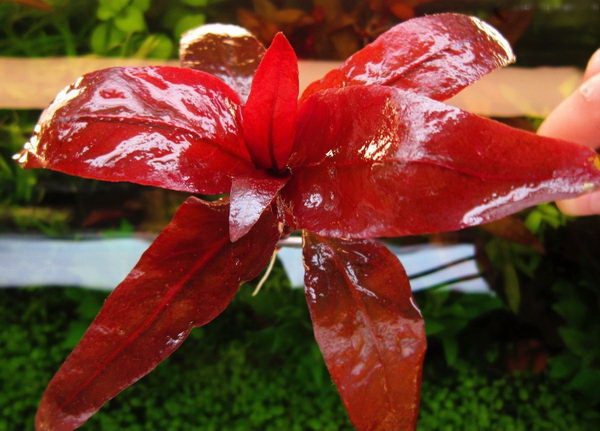

Alternantera lilac for aquarium
In natural conditions, plants are found in reservoirs with low-flow waters, mainly in South America. She only needs clean water and no direct light. Tolerates full immersion, but still prefers to rise slightly above the water.
A beautiful bloom can be observed only above the surface; in the aquarium, the sprouts reach no more than half a meter in height. It acquires a bright shade only with a sufficient content of carbon dioxide in the water. For this, special periodic feeding is done. The plant has another name: the alternate anther is large and is in great demand in aquarium design.
Optimal location in the aquarium
Of course, each owner of the aquarium chooses a place for breeding and growing representatives of aquatic flora on their own, but experienced aqua designers offer a side placement option for alternantera.
As a last resort, the second plan of the center.
This is due to the fact that stems with dense foliage cover a rather large space, and it is undesirable to find them near the front wall.
Some owners of pink alternantera plant it in separate pots, which are then placed on the ground where they see fit.
